Author:
Alfredo Sanz, COO, ADD Semiconductors, Advanced Digital Design S.A., Zaragoza, Spain
Date
09/01/2010
The evolution from the traditional electrical grid to the new smart grid introduces many challenges. One of these main challenges is the need for a good communication network to receive information and control the loads of each customer in real time. The most proven and robust solution for this is the use of Power Line Communication (PLC) technology that uses the grid as the communication medium. Here we discuss the technology and its evolution and compare the traditional narrow band single carrier FSK modulation with the new solutions based in OFDM which are known as PRIME and G3. The traditional electrical grid is changing. In the last century the electrical grid was a system designed to distribute the energy produced from a relatively small number of generation points to an enormous number of customers of different sizes in terms of usage. The criterion to design and to operate the grid was to transport the energy in an efficient way from the centres of generation to millions of customers. The capability to store energy in this system was very limited and therefore the capability to forecast the energy consumption was critical. The control of the grid was based on a daily forecast and the flow of the energy was from centres of production, via the transport grid, to the distribution grid. Most of the production was under the control of a regulator.
Now in some countries, and certainly more in the near future, the contribution of green energies to the electrical grid is a highly significant and important factor. The contribution of so-called green energies to the electrical grid is moving from 5% of hydroelectric production to nearly 40%, made up mainly of solar and wind energy. For the majority of this green energy the regulator normally has a limited control. Additionally, to compound the issue, the electrical vehicle (EV) is becoming a reality and will, for sure, change the scenario. The predicted massive deployment of EV will potentially double the energy consumption in the grid and will as a by-product introduce a large capability to store energy in a distributed structure. This predicted rise in energy consumption, the spreading of green and uncontrolled generation together with the storage capability of EV has been defined as the �perfect storm' for the electric grid. The solution to this threat was defined as the smart grid. It is a combination of embedded intelligence and real time communication and control capability with enough capillarity to control and communicate to any of the millions or hundreds of millions of users in real time. To achieve this capability of communication it is necessary to actually utilize the electrical grid as the main communication medium using PLC technology.
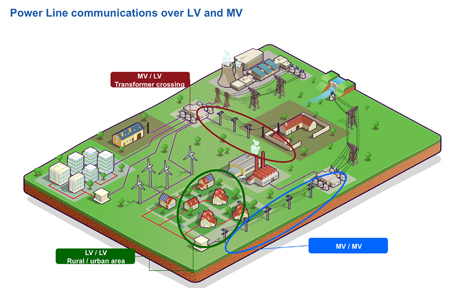
PLC technology has been used in MV to control the electrical grid for over 20 years. But the massive use of PLC on the LV side of the grid is more recent. A huge success story here is the massive deployment of an AMM (Automatic Meter Management) system of 35 million meters in Italy by the ENEL utility using a narrow band PLC system based on FSK and BPSK modulation. This system provides the capability to perform accurate bimonthly reading of the 35 million meters, but unfortunately the average baud rate is limited which prevents more real time information and control. Future applications will be based in protocols such as IPv6.
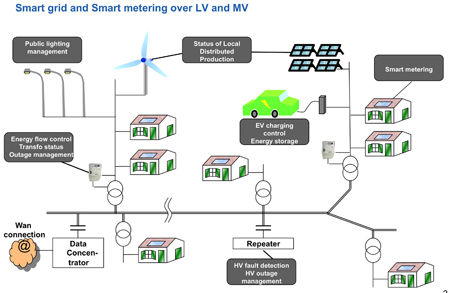
To support more real time information, control and future applications based on protocols as IPv6, makes it necessary for a new generation of PLC technology based in OFDM modulation schemes to be utilized. The two main OFDM proposed solutions are now G3 and PRIME. G3 is a solution promoted by the French utility, EDF, and developed by MAXIM and SAGEMCOM. This solution has been made public from 2009 and EDF plans to test 2000 meters utilizing G3 by 2013. PRIME is an open and multi provider solution promoted by the PRIME Alliance which includes more than 30 companies such as utilities, meter manufactures, and silicon providers such as ADD Semiconductors, FUJITSU, STM, and TI. Meter manufactures involved in the PRIME Alliance include SAGEMCOM, ITRON, LANDIS+GYR, ISKRA-MECO, ZIV, SOGECAM. IBERDROLA was the initial utility promoter but now EDP, CEZ MERENI and ITRI are also members.
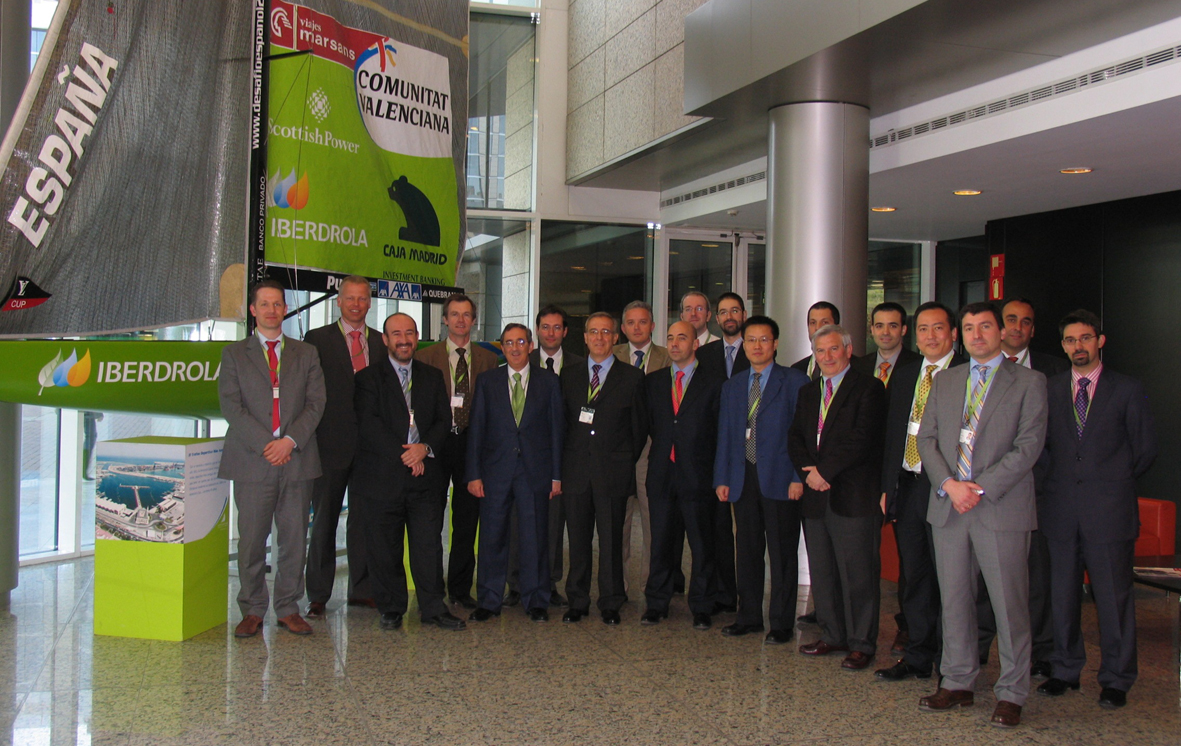
IBERDROLA was the company that started the deployment of 100,000 meters in 2010, and the company is now planning a new tender for 1 million meters by the end of 2010 and to complete the full deployment of 10 million meters in Spain within 3 to 5 years. Other utilities are also starting to introduce PRIME.
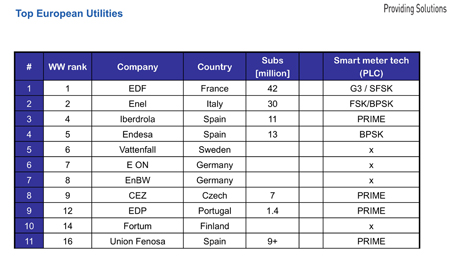
G3 and PRIME are both OFDM solutions but with a different history. G3 initially used a chip designed by MAXIM that provided the PHY layers and some available software layers as in IEEE 802.15.4 2006, using 6LowPAN for the MAC layer and IPv6 for the Network layer. PRIME is the result of the collaboration of a multi-disciplinary consortium including utilities, industrial and university partners to design a new OFDM-based power line technology open standard. The consortium used a systematic process of design for the PHY layer starting from basic requirements. The next step was the characterization of the physical medium in terms of noise level, noise patterns, attenuation characteristics and models of impedances. The industrial partners developed new automatic equipment specific for these tasks and several records were accumulated in collaboration with the utility. This process delivered a large database of noise level, noise patterns, attenuation characteristics and models of impedances that provided a statistically accurate model of the grid. In a second step, this model was used to evaluate, by simulation, several alternative combinations of parameters of the OFDM technology including header implementation, bandwidth allocation, number of subcarriers, subcarrier modulation and error correction. The best alternatives were evaluated in the field using the new equipment. After several iterations and a massive field test, the best combination of parameters was selected according the condition of the European grid and the specification of the utility. Also the MAC and upper layers are the result of a collaborative consortium including silicon providers, meter manufactures and utilities. The net result of these combined efforts is the finalization of the PHY, MAC and Convergence layers. The PHY transmits and receives MPDUs (MAC protocol data units) between neighbouring nodes. The average transmission rate of the PHY layer is around 70kbps and the maximum is 120kbps using a frequency bandwidth of 47.363kHz located on the high frequencies of the European Committee for Electrotechnical Standardization, CENELEC, A-Band. In 92% of cases there is direct visibility of the nodes of the network. In all other cases the routing assures 100% connectivity.
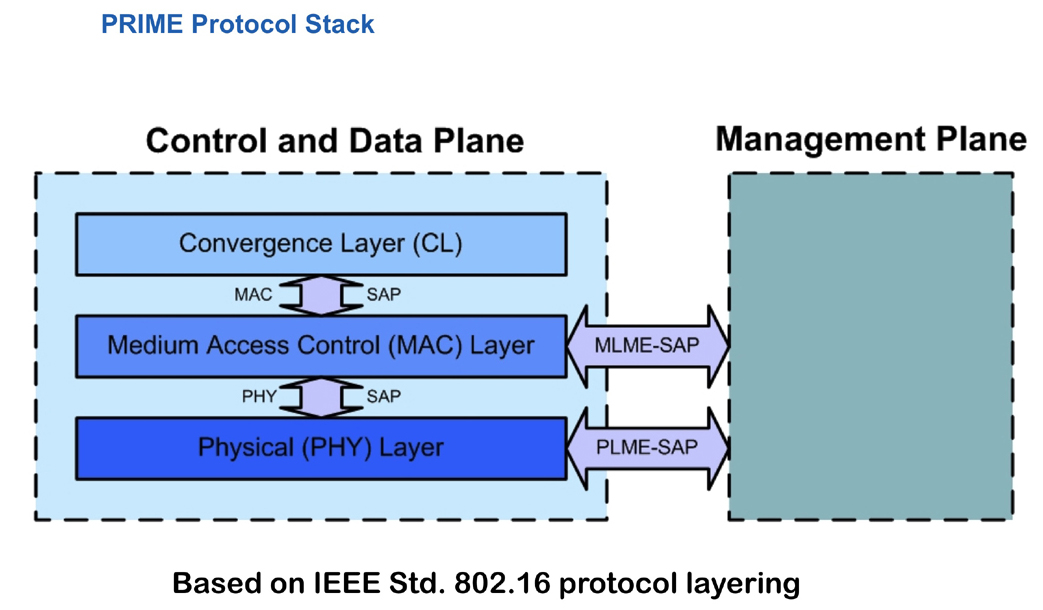
The MAC layer provides core MAC functionalities of system access, bandwidth allocation, and connection establishment/maintenance and topology resolution. The service-specific Convergence Layer (CL) classifies traffic associating it with its proper MAC connection. This layer performs the mapping of any kind of traffic to be properly included in MAC Service Data Units (SDUs). It may also include payload header suppression functions. Multiple Convergence sublayers are defined to accommodate different kinds of traffic into MAC SDUs. In the basic FSK or BPSK the information is transported in a single carrier. The baud rate used is proportional to the bandwidth, but the noise and selective attenuation can limit the communication. In OFDM solutions the information is transported in several subcarriers. The baud rate used is proportional to the bandwidth and the complexity of modulation of the subcarriers; DBPSK, DQPSK or D8PSK. The uses of several subcarriers, the coding and error correction used provide more robustness for the noise and selective attenuation in the communication.
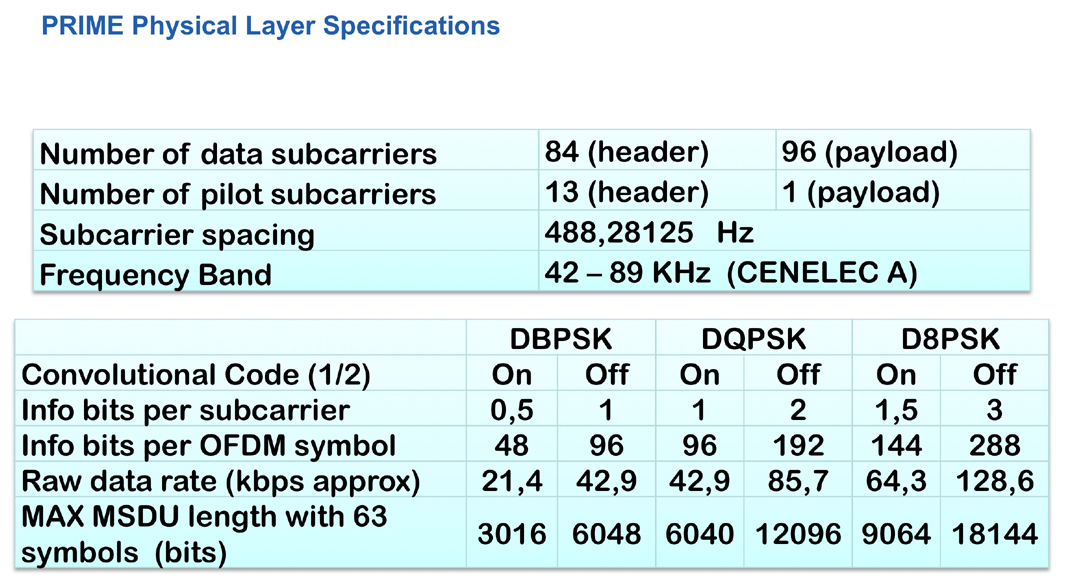
Size of the data transmitted (symbol) is proportional to the sampling frequency and the number of sub-carriers. The size of the symbol increases the robustness for impulsive noise. Coding increases the robustness but also increases the complexity and power consumption. It is the number of subcarriers that provides more robustness, not a higher baud rate. The G3 solution uses 36 subcarriers and sort symbols of 0.735ms, preamble of 6.79ms, headers of 9.5ms and need repetition and Reed Solomon (cyclic error-correcting codes) error correction to increase robustness. The PRIME solution uses 97 subcarriers and long symbols of 2.24ms, preamble of 2ms, headers of 4.48ms. To avoid the need for repetition and the complexity of Reed Solomon error correction Prime uses symbols with 3 times more energy to increase robustness. This is a more cost effective solution to increase robustness. In conclusion, the electrical grid is evolving into a smart grid which needs greatly improved communication capabilities. PLC technology is the most convenient technology to achieve the necessary capillarity and robustness. The PLC technology is evolving to OFDM solutions with G3 and PRIME as the main alternatives. www.addsemi.com